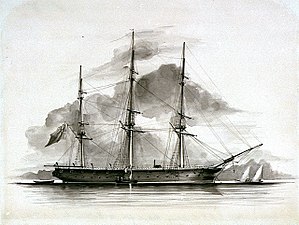 Brisk, Capt A. F. R. de Horsey drawn in 1860
| |
| History | |
|---|---|
| Name | HMS Brisk |
| Ordered | 25 April 1847 |
| Builder | Woolwich Dockyard |
| Cost | £47,482 |
| Laid down | January 1849 |
| Launched | 2 June 1851 |
| Completed | 24 August 1853 at Devonport Dockyard |
| Commissioned | 24 May 1853 |
| Decommissioned | 19 January 1869 |
| Honours and awards | Pacific 1854–55 |
| Fate | Sold on 31 January 1870 |
| General characteristics as built | |
| Type | Screw sloop (corvette from 1862) |
| Displacement | 1,474 long tons (1,498 t) |
| Tons burthen | 1,086 90/94 bm |
| Length |
|
| Beam | 35 ft (10.7 m) maximum, 34 ft 6 in (10.5 m) reported for tonnage |
| Draught | 14 ft 8 in (4.5 m) forward, 16 ft 8 in (5.1 m) Aft |
| Depth of hold | 20 ft 5+1⁄4 in (6.2 m) |
| Installed power |
|
| Propulsion |
|
| Speed |
|
| Complement | 170 to 175 |
| Armament |
|
HMS Brisk was a 14-gun wooden-hulled screw sloop designed by the Committee of Reference as part of the 1847 program. She is considered an enlarged Rattler with the design approved in 1847.[1] She was ordered on 25 April 1847 from Woolwich Dockyard as a 10-gun sloop,[2] but the guns were later increased due to the Russian War, to 14 guns by increasing the number of 32-pounder guns. She was launched on 2 June 1851 from Woolwich Dockyard.[3] She served in the Russian War of 1854- 55 and as part of the Southern African anti-slavery patrol, with a final commission on the Australian Station. She was sold in 1870 for use in a pioneer, but unsuccessful, telegraph service.
Brisk was the fourth vessel of the name, since it was introduced for a 16-gun sloop launched by Jacobs of Sandgate on 6 May 1784 and sold in May 1805.[4]